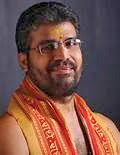Spiritual Import of Religious Festivals -16-9.
05/09/2018
Chapter 16 : The Significance of Ekadasi - 9.
A talk given on the 17th of January, 1970, on the request of devotees.
There is no medicine at all. So, Homeopathy says that they give no medicine, but a vibration – a vibration of the original base material. It is a subtle aromatic vibration, aromatic in the sense of the subtle residuum of the original medicine; and what will create a circumstance in Allopathy will remove that very circumstance in Homeopathy. Nevertheless this potency is material in the sense that it is formed of matter. So is the mind. It is the subtle portion of the material substance of our food. The subtle essence of the food, not only directly taken through the mouth but through all senses, contributes to the make-up of the mind or the mind-stuff.
Mind is material in a subtle sense, like a mirror which is made of earth material only, though it shines. Only the mirror is able to reflect light, and not the brick, though it is also made of the earth material. Mind is material in this sense. It is very, very subtle and is made up of everything that we take. So, matter influences matter. Planets are not spiritual bodies, and yet they influence the mind. The mind's presiding deity is the moon.
Ekadasi is particularly relevant to this relation of moon and mind. You will find that, when you go deep into the study of astronomy, you have nothing in your body except some planetary influences! We are made up of planetary forces and there is nothing independent to call our own. One part belongs to one planet and another part to another planet. If each planet claims its part, you will disintegrate. The moon influences the mind in its orbital relative movement with reference to other planets and us.
Another important aspect is the seat of the mind, which is also twofold. You may be living in many houses, of which one or two are your own. Svasthana means 'one's own place'. The mind has several abodes or centres of energy called Chakras, of which two are its own. The seats of the mind in this personality of ours are: 1. the subtle spot in the astral body corresponding to the centre of the two eyebrows, in waking, and 2. the heart, in the state of deep sleep. If it is in the brain, it is active and you, then, do not get sleep, because it refuses to go down. If the mind is midway between the centre of the eyebrows and the heart, it is the dream state.
So, there is a twofold centre of the mind – the Ajna Chakra, or the centre between the eyebrows, and the Anahata Chakra, or the heart. In both these centres, the mind feels at home and is at ease, because it is nearer to itself. In other centres it is extrovert. In the Ajna and the Anahata Chakras it finds itself at home. In the two fortnights, in its movement, it finds itself at the Ajna Chakra and the Anahata Chakra on the eleventh day.
Since these two Chakras are its own abode, the mind is at home here, i.e., it gets concentrated and collected easily. This has been the experience given out by our ancients, and this has to be taken advantage of by Sadhakas. You are capable of concentration when the mind is naturally in its home. The mind cannot be concentrated when it is out of tune, but when it is in its location it is easy of contemplation.
So, the Ekadasi day in both fortnights is the occasion when the mind finds itself in its place – in the bright fortnight in the Ajna Chakra, and in dark fortnight in the Anahata Chakra. Seekers and Yogis take advantage of these two days and try to practise deep meditation. Vaishnavas treat Ekadasi as a very holy day and also observe a fast on that day.
To be continued ..





Comments